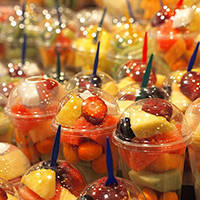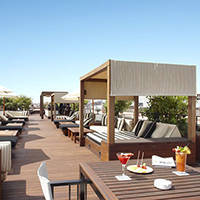Barcelona Ramblas: what not to miss and what to avoid

The Ramblas avenue (also called La Rambla) is the best known and the busiest street in Barcelona. Linking the Plaça de Catalunya to the port, it is unavoidable for all tourists visiting the Catalan capital. It is 1.2 kilometres long and and often inundated with pedestrians.
History of the Ramblas
Originally la Rambla was a stream surrounded by ramparts, where water ran towards the sea. During the 16th and 17th Centuries convents and educational or cultural centres began springing up along it.
At the end of the 17th Century, the wall was destroyed and the Rambla took its current form: a long wide avenue for strolling pedestrians. Wealthy families built their family homes and the old convents became public spaces such as markets or theatres.
La Rambla then became a bastion of the bourgeoisie and its growing popularity gradually brought flower and bird stalls and shops. The city hall installed public benches, fountains and pretty lanterns.
The Ramblas today

Have you ever wondered why people talk about the Ramblas sometimes in plural and sometimes in singular? Well the Ramblas are made up of 5 sections:
- Rambla dels Canalettes, which gets its name from the Canalettes fountain, installed on the Rambla closest to the Plaça Catalunya. Legend has it that visitors who drink its water come back to Barcelona. It is also the meeting point for Barça fans the evening following a victory.
- Rambla dels Estudis, where a University built in the 15th century was once found. The building was destroyed in 1843.
- La Rambla de la Flores, where the flower stalls live. In the 19th Century it was the only place in the city where they were found!
- La Rambla dels Caputxins, which houses an old Capuchin monastery.
- Rambla de Santa Monica, which gives onto the port. It takes its name from the parish of Santa Monica, where it is situated. This Rambla is known for the artists who come to paint the Barcelona city hall.
- Today the Ramblas have unfortunately lost their authenticity. They have become a symbol of mass tourism in Barcelona and residents avoid them as much as possible during popular times. Pickpockets on the other hand, make great use of them!
The Ramblas attractions not to miss
Walking down the Ramblas you can easily drown in the impressive sea of tourists, and wind up missing some of the best sights. Open your eyes wide to make sure you don’t miss out!
- If you want a guided tour of the Ramblas and its surroundings, the tourist office offers a very interesting visit on a low budget!
 La Boquería market: La Boquería market is one of the biggest attractions of the Ramblas. Once you have passed the beautiful art nouveau entrance, you will discover a whole array of products that are as beautiful as they are tasty. It’s not surprising that la Boquería features in our top 5 markets in the city! Head down to take a tapas break at the market’s famous Pinotxo stand.
La Boquería market: La Boquería market is one of the biggest attractions of the Ramblas. Once you have passed the beautiful art nouveau entrance, you will discover a whole array of products that are as beautiful as they are tasty. It’s not surprising that la Boquería features in our top 5 markets in the city! Head down to take a tapas break at the market’s famous Pinotxo stand.
: The Ramblas are flanked by bourgeois buildings of remarkable architecture. At numbers 61-65 stands the superb Liceu theatre, which is currently an opera house. Built in the 19th century, it was burned twice and totally rebuilt in 1999, and restored to its original splendour.
: this baroque and rococo building belongs to the city of Barcelona, which has transformed it into an Image Centre. It hosts photography exhibitions all year long and entry is free! More info is available in our article Palau de la Virreina: free photo exhibitions on the Ramblas.
: There is more to see on the Ramblas than just buildings, the ground is also worth a look! Between the Boquería market and the Liceu theatre, a Joan Miró mosaic entitled “Pla de l’Os” adorns the pavement. And it’s not the only Miró in a public space. Learn more in our article Public art in Barcelona.
: Food lovers will be delighted to learn that one of Barcelona’s best loved bakeries is located on the Ramblas. The shop has been here since 1902 and it is one of the prettiest in the whole of Barcelona, and features in our article on Barcelona’s iconic shops on the Ramblas.
: Among our favourite hotel terraces, the 1898 is one of the best. It’s the perfect place to take a break from the tumult of the Ramblas. Although be careful as the prices are quite high (expect to pay around €15 for a cocktail).
: Something for the kids! At the bottom of the Ramblas, near the port, lots of living statues amuse the young and old. They are men and women in spectacular costumes who stay perfectly still until you give them a coin.
Behaviours, attractions and times to avoid
Pickpockets and crowds
To avoid disaster, read our anti-pickpocket tips.
Restaurants and cafés
The rule is simple: avoid all restaurants and cafés on the Ramblas. Most of them are very poor quality and aim to simply provide a minimal offering to the passers-by, of which there are so many they are never short of customers.
Recommended times
From May to October the Ramblas are black with people. Peak time is mid-July to mid-August. But even during that time you can get down the Ramblas in relative quiet if you head there between 9am and 10am.
Avoid the Ramblas at night. It’s not very dangerous but it becomes a quiet area, populated by people with bad intentions.
Now you’ve been warned, all you have to do is enjoy your stroll!







